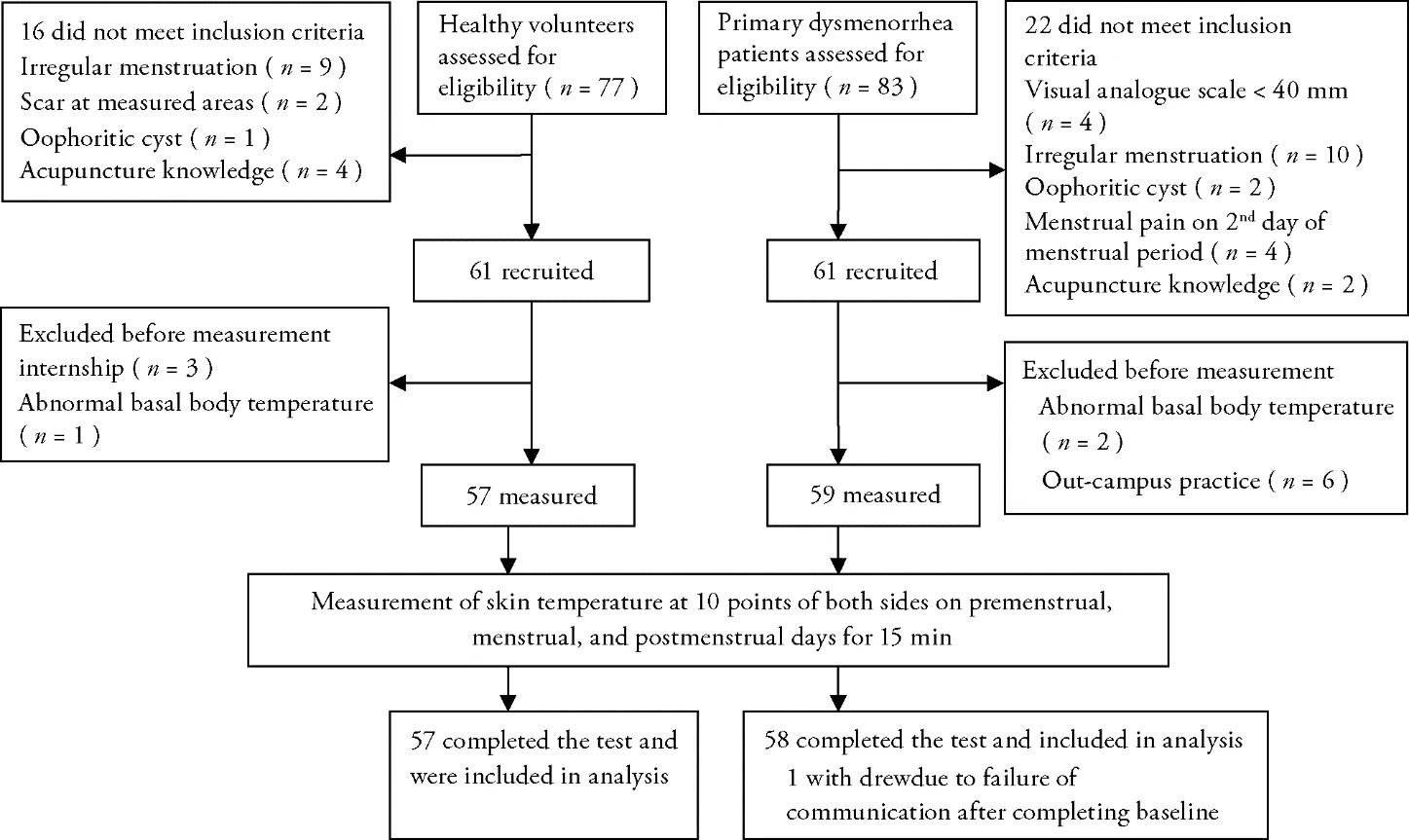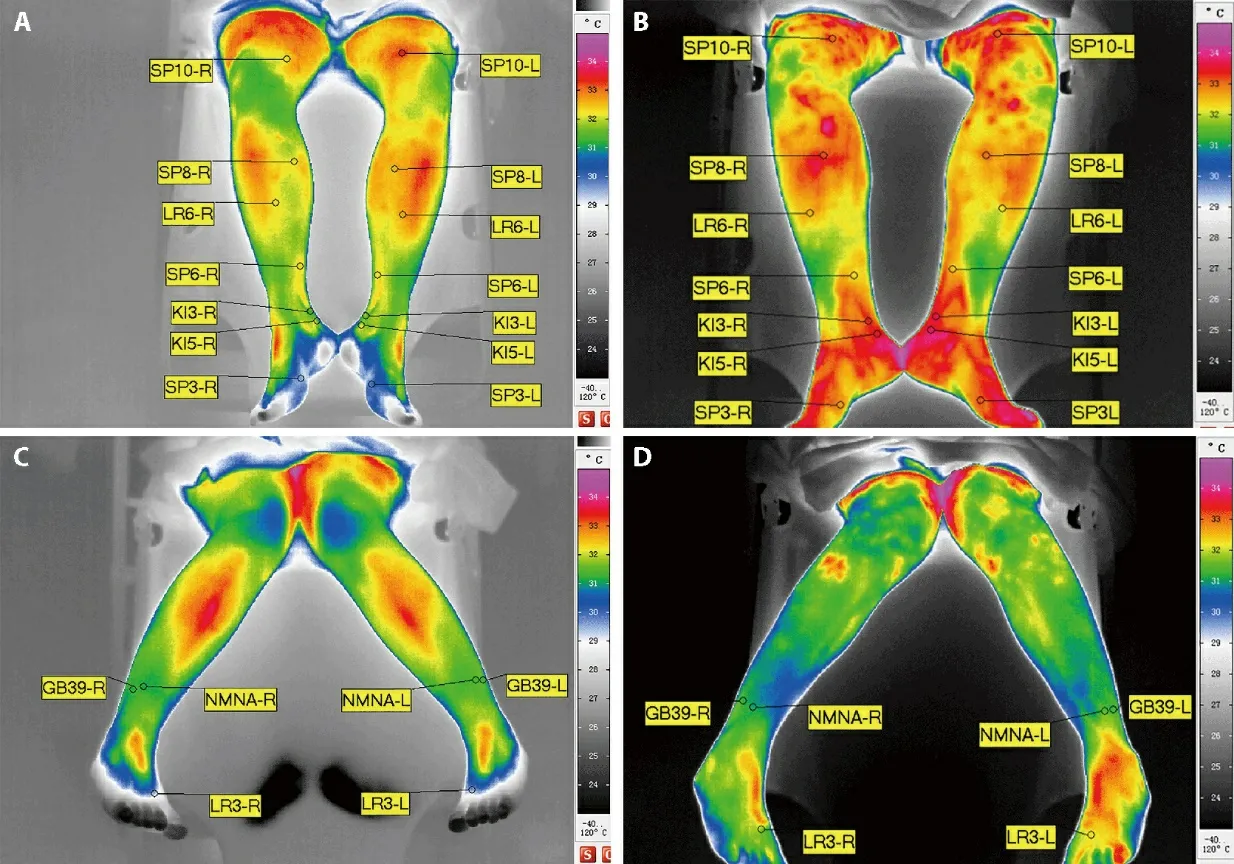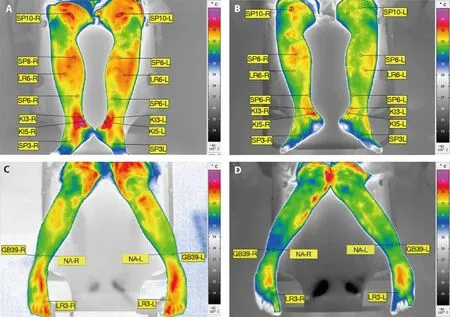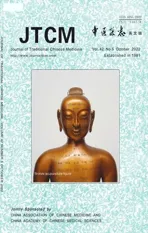An infrared thermographic analysis of the sensitization acupoints of women with primary dysmenorrhea
2022-10-14FANXishengDUXiaoyiPANLijiaSONGXiaodanLIUJunZHANGJunchaCHENHaoGAOYayuZHANGMingjianSHIXuliangSHEYanfen
FAN Xisheng,DU Xiaoyi,PAN Lijia,SONG Xiaodan,LIU Jun,ZHANG Juncha,CHEN Hao,GAO Yayu,ZHANG Mingjian,SHI Xuliang,SHE Yanfen
FAN Xisheng,SONG Xiaodan,CHEN Hao,GAO Yayu,ZHANG Mingjian,Graduate School,Hebei University of Chinese Medicine,Shijiazhuang 050091,China
DU Xiaoyi,Depeartment of TCM Pediatric,Shijiazhuang Maternity and Child Healthcare Hospital,Shijiazhuang 050051,China
PAN Lijia,SHE Yanfen,Department of Experimental Acupuncture,School of Acupuncture-Moxibustion and Tuina,Hebei University of Chinese Medicine,Shijiazhuang 050200,China
LIU Jun,Department of Rehabilitation,School of Acupuncture-Moxibustion and Tuina,Hebei University of Chinese Medicine,Shijiazhuang 050200,China
SHI Xuliang,Department of Basic Teaching and Research of Acupuncture,School of Acupuncture-Moxibustion and Tuina,Hebei University of Chinese Medicine,Shijiazhuang 050200,China
PAN Lijia,SHE Yanfen,LIU Jun,ZHANG Juncha,SHI Xuliang,SHE Yanfen,Hebei International Joint Research Center for Dominant Diseases in Chinese Medicine and Acupuncture
Abstract OBJECTIVE: To explore the sensitization acupoints of women with primary dysmenorrhea (PD) by comparing infrared radiation temperatures between acupoints and non-acupoints.METHODS: We tested 10 acupoints of every woman with PD and healthy subjects on premenstrual,menstrual,and postmenstrual days using an infrared imaging device.The primary outcome was the absolute value of body surface temperature difference (AVTD) between the left and right sides of the same testing point.RESULTS: A total of 58 PD patients and 57 healthy volunteers completed the test from May 2016 to May 2017.Compared with the healthy group,we observed a significant reduction and increase in the AVTD in Taichong (LR3) and Sanyinjiao (SP6),respectively,during menstrual days in the PD group (P =0.01;P =0.04);while during postmenstrual days,all AVTDs of Shuiquan (KI5),Diji (SP8),and Xuehai (SP10) were diminished in the PD group (P =0.01;P =0.03;P =0.01,respectively).No significant differences in AVTD were detected at any other points or testing times.CONCLUSIONS: Compared with the healthy group,the AVTDs of Taichong (LR3),Sanyinjiao (SP6),Shuiquan(KI5),Diji (SP8),and Xuehai (SP10) at menstruationrelevant points of PD patients were sensitized,providing a reference for the selection of acupoints in the treatment of PD.
Keywords: dysmenorrhea;menstruation;infrared thermal imaging;acupoint sensitization;specific acupoints
1.INTRODUCTION
Primary dysmenorrhea (PD) is one of the most commonly encountered diseases of gynecology,with an incidence of 50%-90%.1-3Although PD does not manifest an organic change in the reproductive organs,symptoms of abdominal pain before and after menstruation or during menstruation,abdominal distension,or other discomfort can seriously affect women's physical and mental health.4In the clinical guidelines for PD developed by the Canadian Association of Obstetricians and Gynaecologists (SOGC)in 2017,acupuncture was included as one of the complementary and alternative-therapy treatments for PD;4however,the definitive points of acupuncture therapy have not yet been determined by consensus.Research shows that Sanyinjiao (SP6),Diji (SP8),Xuehai (SP10),Taichong (LR3),and other acupoints are commonly used to treat dysmenorrhea;5and a secondary analysis of data from a multicenter,randomized controlled trial for PD suggested that Sanyinjiao (SP6)exerts a specific effect on immediate pain relief in PD participants using a cold and damp stagnation pattern.6Evidence,however,remains inconclusive.
The classic bookLing Shuposited that to take the reaction point as the treatment site is the key step in clinical efficacy;and this reaction is now referred to as acupoint sensitization.However,most researchers have focused on exploring the specificity of acupoints in treating diseases;7-12and current clinical studies show that it is difficult to judge the specificity of acupoints because acupuncture manifests both broad and specific effects in relieving pain;13however,the sensitization of acupoints can reveal the correlation between Zang-fu viscera and meridians and acupoints.In this study,we explored the sensitized points of PD and thus provided a theoretical basis for acupoint selection in clinical treatment.
Medical infrared thermal-imaging technology detects the infrared signals of an object’s thermal emission through non-contact means,converts the thermal signals into visual images,and ultimately presents these in a hierarchically stepped thermal map that reflects the variations in human radiation energy.7Currently,this technology is used widely in investigations of the classical theory of Chinese medicine,the sensitization of acupoints and meridians,acupuncture techniques,observation of acupuncture efficacy,and other aspects.14-17Several studies have suggested that body surface temperatures of acupoints and meridians constitute a sensitive and valuable index to facilitate the evaluation of human health.15,18,19
Thus,we explored sensitization acupoints of PD patients through a comparison of the infrared radiation temperature differential between acupoints and nonacupoints (NA).Our previous research indicated that compared with the non-menstrual period,the body surface resistance of some acupoints in the menstrual period was significantly different.In our previous study,however,we lacked data from the pre-menstrual period,and acupoint sensitization images were not presented.Therefore,we herein evaluated the points that were identical to the previous study20using an infrared thermal-imaging instrument that could objectively map the body surface temperatures of acupoints and NA,and chose three timepoints: one to three days before menses(hereafter referred to as “premenstrual day”),the“menstrual day” (i.e.,onset of menses),and the third postmenstrual day (hereafter referred to as“postmenstrual day”) to explore sensitized reactions with respect to the infrared radiation temperatures of acupoints at different timepoints in a relatively complete menstrual cycle.
2.PARTICIPANTS AND METHODS
2.1.Participants
We recruited a total of 58 PD patients and 57 healthy volunteers who completed the study at the Hebei University of Chinese Medicine (HUCM,Hebei Province,China).This study was also conducted at HUCM,approved by the Medical Ethics Committee of HUCM on February 2015 (YXLL2015002),and followed the principles of the Declaration of Helsinki.Signed informed consent was obtained from the participants in the study.
2.2.Inclusion and exclusion
Eligible participants in the PD group met the following inclusion criteria: (a) satisfied the diagnostic criteria of PD inthe Primary Dysmenorrhea Consensus Guidelinedeveloped by the SOGC;21(b) experienced menstrual pain on the first day of their menstrual periods;(c) were between 18 and 30 years of age without a history of delivery;(d) exhibited a normal menstrual cycle (21 to 35 d in length per cycle);(e) had a course of menstrual pain from 6 months to 15 years;(f) experienced menstrual pain,scoring 40 mm or more on a 100-mm visual analogue scale (VAS) for three consecutive periods;(g) accepted no oral analgesics or any other therapies 24 h before imaging evaluation;(h) possessed a normal body temperature and did not have a common cold one week before evaluation;and (i) voluntarily participated,showed good compliance when enrolled,and signed an informed consent form before participation.Participants in the healthy group experienced no menstrual pain or history of chronic diseases,and the other criteria were the same as for those in the PD group.
2.3.Exclusion criteria
We excluded participants for the following reasons: (a)those who had PD combined with serious life-threatening primary diseases,such as cardiovascular or cerebrovascular diseases and liver,kidney,or hematopoietic system diseases,as well as patients with mental illness,active-stage gastric ulcers,or asthma;(b) those with muscular pain,dermal diseases,or peripheral nervous system diseases;(c) participants with history of acupuncture treatment and knowledge of acupuncture;and (d) patients with scars at the detection position.
2.4.Testing equipment and environment
A long-wave,uncooled,portable infrared thermal-image system (InfraTec GmbH,Dresden,Germany)was applied for infrared testing.The spectral range of this instrument was from 7.5 to 14 micrometers,resulting in a thermal image of 1280 × 960 pixels;the temperature range was from-40 ℃ to 1200 ℃;the measurement accuracy was from-1.5 ℃ to +1.5 ℃;and the thermal sensitivity was 0.05 ℃.This study was performed in the laboratory of the scientific research center at HUCM.The indoor temperature at testing was controlled between 21.98 ℃ and 25.8 ℃,and the humidity was 37.26%–56.92%.The outside temperature was between 5.08 ℃ and 23 ℃ and the humidity was 27.63%–75.17%.
2.5.Detecting points and methods
We selected eight menstruation-relevant acupoints—Diji(SP8),Zhongdu (LR6),Shuiquan (KI5),Taibai (SP3),Taichong (LR3),Taixi (KI3),Sanyinjiao (SP6),and Xuehai (SP10)—and one menstruation-irrelevant acupoint,Xuanzhong (GB39),based upon a previous study.20All acupoints were located followingtheWorld Health Organization Standard Acupuncture Point Locations in the Western Pacific Region,22and the NA location was per a previous study (Figure 1).23To ensure consistency of assessment,all points in every participant throughout the entire study were located and marked on the skin by the same senior licensed acupuncturist who had more than 10 years of clinical experience in an academic acupuncture clinic.
2.6.Procedures
Our trial procedures were as follows: (a) Subjects contacted the researchers and arrived at the laboratory on the premenstrual day.(b) Upon entering the laboratory,the subjects rested in the natural state for 15 min after the exposure preparation at the test site;during this period,the subjects’ axillary temperature was determined with a mercury thermometer.(c) The subjects were positioned as in Figure 1,and the acupuncturist located all 10 points on both sides and made marks on the surface of skin with an ink marker.(d) An infrared camera was used to ascertain the surface temperatures at the seven points on the medial sides of the lower extremities [Taixi (KI3),Taibai (SP3),Shuiquan (KI5),Diji (SP8),Zhongdu(LR6),Sanyinjiao (SP6),and Xuehai (SP10)].(e) After 15 min of continuous measurement,the remaining three points on the lateral sides of the lower extremities[Taichong (LR3),Xuanzhong (GB39),and NA] were measured for 15 min each.(f) On the menstrual day(within 24 h) and the postmenstrual day,we repeated the same procedure at the same time per the previous measurement.We used IRBIS 3 Standard software(InfraTec GmbH,Dresden,Germany) to process the data and export the data in the form of Excel spreadsheets.

Figure 1 Infrared image of the measured acupoints
2.7.Quality control
The acupuncturist was separated from the measuring technician during the trial,was asked to maintain neutrality and to communicate with the participants only when necessary,and was not allowed to talk with the participants when the measurement started.Both were blinded to measurement allocation.The data were analyzed by a third party (School of Mathematics,Hebei University of Economics and Business) who was blinded to group allocation and testing points.
2.8.Outcome measures
We found that the body surface temperatures of acupoints were affected by the testing environment,24and thus we selected the absolute value of the body surface temperature difference (AVTD) of the same acupoints on both limbs as the primary outcome to objectively reflect the physiologic and pathologic changes within the body.
2.9.Statistical analysis
We employed SPSS v.19.0 (SPSS Inc,Chicago,IL,USA)to analyze all data.Medians (P25,P75) were used for statistical descriptions of measurement data.Differences were considered to be statistically significant atP< 0.05.We used the least significant difference test for the comparisons between different periods in accordance with normally distributed data with a homogenous variance and used the Kruskal-Wallis test for the comparison between different periods in accordance with heteroscedasticity and nonnormal data.
3.RESULTS
From May 2016 to May 2017,we assessed a total of 160 female students from Hebei University of Chinese Medicine and recruited 122.Because five individuals were excluded according to our criteria,58 PD patients and 57 healthy volunteers were measured and 115 participants finished the trial (one patient withdrew due to lost contact after completing the baseline study)(Figure 2).There were no statistically significant differences in the baseline characteristics between the two groups (Table 1).
3.1.Comparison of different times between healthy and PD groups
On premenstrual day,there was no significant differences in the AVTD at any testing point between the two groups (P >0.05).However,we observed in the between-groups comparisons that the AVTD of PD group had a statistically significant decreases at Taixi(LR3) [0.09 (0.32,0.50) versus 0.40 (0.20,0.66),P=0.01] and a statistically significant increases at Sanyinjiao (SP6) [0.37 (0.15,0.72) versus 0.33 (0.13,0.57),P=0.04] (Figure 3) on menstrual day compared with those values with the healthy group.Other points showed no significant differences (Table 2).When comparing the values on the postmenstrual day,the PD group also exhibited a statistically significant reduction in AVTD at Shuiquan (KI5) [0.26 (0.15,0.51) versus 0.25 (0.12,0.52),P=0.01],Diji (SP8) [0.27 (0.11,0.45)versus 0.37 (0.17,0.64),P=0.03],and Xuehai (SP10)[0.22 (0.09,0.51) versus 0.39 (0.21,0.62),P=0.01]compared with the healthy group (Figure 4).Other points showed no significant differences (Table 2).

Figure 2 Flow chart of participants throughout the study

Figure 3 Infrared image comparing healthy Group and PD group on the menstrual day

Figure 4 Infrared image comparing the healthy and PD groups on the postmenstrual day
Table 1 Baseline characteristics of participants in two groups ( ± s)

Table 1 Baseline characteristics of participants in two groups ( ± s)
Notes: P values from between-group comparisons using a t test.PD: primary dysmenorrhea.There was no statistically significant difference when comparing the two groups.

4.DISCUSSION
With respect to both the PD and healthy groups,the AVTD of Taichong (LR3) diminished whereas that of Sanyinjiao (SP6) increased on the menstrual day;and the AVTDs of Shuiquan (KI5),Diji (SP8),and Xuehai(SP10) were significantly reduced on the postmenstrual day.No significant difference in the AVTD was detected at any other points or testing times.These comparisons suggested that Taichong (LR3),Sanyinjiao (SP6),Shuiquan (KI5),Diji (SP8),and Xuehai (SP10) might specifically reflect PD disease;and the classic acupuncture theory and visceral-surface-reflex theory provided some indications as to these results.
In classic acupuncture theory,the Taichong (LR3) point is theYuan-source point of the liver meridian;and the Sanyinjiao (SP6) point is the crossing point of three yin meridians of the foot,spleen,liver,and kidney.TheYuan-source point refers to the point where the originalQiof the visceral organs pours,passes,or stays;and the crossing point is the point at which two or more meridians or channels intersect.25In Traditional Chinese Medicine (TCM),the spleen,liver,and kidney are the three principal viscera related to the uterus.The kidney is the congenital basis of a woman,the spleen provides the material basis for the acquired constitution,and the liver is the major regulatory organ.Of these,the relationship between the liver and menstruation is particularly close.Blood is the root of female,which is supported byQi.Menstruation is related toQiand blood and depend on liver function in storing blood and maintaining free flow ofQi.The three yin meridians of the foot are also closely related to the conceptive vessel governing the uterus and gestation,and the thoroughfare vessel governingQiand blood of the entire body by means of the meridian crossing.In addition,Taichong(LR3) and Sanyinjiao (SP6) are commonly used to treat dysmenorrhea.5These may be the reasons for why the AVTDs of Taichong (LR3) and Sanyinjiao (SP6) on the menstrual day in the PD group were significantly different from the healthy group.
Shuiquan (KI5) and Diji (SP8) areXi-cleft points of the kidney meridian and spleen meridian,respectively;and theXi-cleft point is where the meridian or channelQiand blood show enhanced accumulation[25].The Chinese name for Xuehai (SP10) is “blood sea” and its primary function in TCM is to regulate the blood circulation and menstruation.PD patients often have myometrial hypercontractility that results in hypoxia and ischemia of uterine muscle,26which may affect the blood andQiof the uterine after the end of the menstrual period,and this may explain the differences in Shuiquan (KI5),Diji(SP8),and Xuehai (SP10) between the two groups.
According to the theory of visceral-surface-reflex,27the same or adjacent segmental innervation of meridian points and visceral nerves and spinal cord may explain the acupoint reaction.The Xuehai (SP10) is located in the third lumbar vertebra (L3),Diji (SP8) and Sanyinjiao(SP6) are located in L4,and Taichong (LR3) and Shuiquan (KI5) are located in L5.The uterus in TCM is equivalent to the internal genitalia of the female reproductive system in Western medicine — including the uterus,fallopian tube,ovary,and vagina.The sympathetic segments of the sympathetic efferent fibers of the uterus,fallopian tube,and ovary are located in the twelfth thoracic vertebra and the first lumbar vertebra T12-L1,T11-L1,and T10-T11,respectively,whereas the sympathetic segments of the sympathetic afferent fibers of the uterus,ovary,and appendages are located at T12and L1-3.28-29Our sensitization acupoints were all located in the same or adjacent parts of the spinal segments of the cytopodium.According to the cutaneous segmental innervation map,30we drew a position map of all the selected acupoints at the cutaneous segment.We also noted,however,that although the points were located in the same segment of the spinal cord,the sensitized reactions were different — suggesting that the theory of visceral-surface reflex was not the only explanation.
Investigators have observed that visceral diseases exhibit a relatively specific relationship with pathologic changes in specific portions of the body surface.When a certain viscera is debilitated or impaired,specific reactions such as pain sensitivity,heat sensitivity,depression,papules,subcutaneous nodules,and cord shape appear at some points of the body’s surface that correspond to the disease.31Some researchers have postulated that the functional state of acupoints is not fixed but rather"active":32,33the open/closed nature and strength of acupoints are thus specific,and this changes as a result of the different functional states of the target organs.One study revealed that in rats with acute gastric mucosal injury,the inflammatory exudation points of the rats’body surfaces showed that the distribution of nerve segments were highly correlated with the acupoints of"Pishu" and "Weishu" and that these exudation points were related to the course of disease,reaching a maximum two to three days after the modeling,and gradually subsiding with the self-healing exudation points of the disease.34Through immunohistochemical staining,some researchers have observed that although there were no essential differences between acupoints and NAs at the anatomical level,there were dynamic changes in characteristic histology and cytology.In other words,local neurogenic inflammatory reactions at sensitized acupoints during disease are manifested commensurate with increased secretion of local harmful neuropeptides such as calcitonin gene-related peptide and substanceP.Mast cells aggregate and release inflammatory substances such as histamine,serotonin,nerve growth factor,and others,35,36and these form a specialized environment or "inflammatory soup." These molecules then interact with local receptors to cause local modifications in situ.33When women are at different stages of the menstrual cycle,their hormone levels differ,and the state of the uterus is also distinct.37Therefore,the sensitization acupoints—even within the same menstrual cycle—also vary.
Our previous studies showed that Diji (SP8),Sanyinjiao(SP6),and Taichong (LR3) were sensitized during menstruation or PD,20,38which was consistent with the results of this study.The difference was that there were more positively reacted points in this study,which might be due to the following reasons: first,the instrument in the previous test was older and the probe had to be affixed to the skin surface during the test,and this may have affected the data;second,some studies have shown that the distribution areas of physiologic characteristics of the bodily surfaces of the participants were different because of their differing constitutions and various TCM patterns;39,40and third,the indices used in the two experiments were different.Therefore,the different results of the two tests may be related to the instruments used,and the proportions of the body constitution and TCM patterns of the included subjects and indices.
In the present study,we uncovered some sensitized acupoints that reflected PD in a relatively complete menstrual cycle,and their features were presented objectively by infrared thermography.This provided evidence for acupoint selection in the analysis of the mechanism governing acupoint sensitization and the clinical treatment of PD.Some researchers showed that the rise in the surface temperature of the meridians was a major symptom of disease.41-42In our study,however,we found that acupoints presented disparate and specific reactions.In fact,the changes that we observed with respect to various indices for the same acupoint in the same disease state of the body were also decidedly different in comparison to previous studies.Furthermore,because of our small sample size,we could not further analyze the sensitization reaction of acupoints from the perspective of syndromes.In the future,we will conduct large-scale clinical trials and mechanistic studies on the basis of this study to reveal the laws and significance governing the acupoint sensitization,and thereby guide and improve clinical practice.
In conclusion,our results suggested that pathologic information for PD patients was carried on Taichong(LR3),Sanyinjiao (SP6),Shuiquan (KI5),Diji (SP8),and Xuehai (SP10),providing a reference for acupuncture treatment of PD points.How the sensitization of these acupoints reflects PD and whether a certain standard should be followed requires further study.
杂志排行
Journal of Traditional Chinese Medicine的其它文章
- Effectiveness and safety of tripterygium glycosides tablet (雷公藤多苷片) for lupus nephritis: a systematic review and Meta-analysis
- Efficacy of green tea extract on PC3 prostate cancer cells through upregulation of miR-195 expression and suppression of epithelial to mesenchymal transition
- Qilan preparation (芪蓝颗粒) inhibits proliferation and induces apoptosis by down-regulating microRNA-21 in human Tca8113 tongue squamous cell carcinoma cells
- Tenglong Buzhong granules (藤龙补中颗粒) inhibits the growth of SW620 human colon cancer in vivo
- Yajieshaba prevents lipopolysaccharide-induced intestinal barrier injury via anti-inflammatory and anti-apoptosis
- Antihepatofibrotic effect of Guizhifuling pill (桂枝茯苓丸) on carbon tetrachloride-induced liver fibrosis in mice
